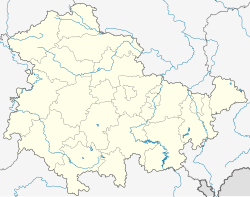Berga, Thuringia
Berga | |
|---|---|
 | |
Location of Berga within Greiz district  | |
| Coordinates: 50°45′N 12°10′E / 50.750°N 12.167°E | |
| Country | Germany |
| State | Thuringia |
| District | Greiz |
| Subdivisions | 14 |
| Government | |
| • Mayor (2018–24) | Heinz-Peter Beyer[1] |
| Area | |
• Total | 43.49 km2 (16.79 sq mi) |
| Elevation | 229 m (751 ft) |
| Population (2022-12-31)[2] | |
• Total | 3,218 |
| • Density | 74/km2 (190/sq mi) |
| Time zone | UTC+01:00 (CET) |
| • Summer (DST) | UTC+02:00 (CEST) |
| Postal codes | 07980 |
| Dialling codes | 036623 |
| Vehicle registration | GRZ |
| Website | Stadt-Berga.de |
Berga/Elster is a town in the district of Greiz, in Thuringia, Germany. It is situated on the White Elster river, 14 km southeast of Gera.
History
Within the German Empire (1871–1918), Berga/Elster was part of the Grand Duchy of Saxe-Weimar-Eisenach.
Berga concentration camp
During World War II, a slave labor camp called "Berga an der Elster"[3] was operated here to dig 17 tunnels for an underground ammunition factory. Workers were supplied by Buchenwald concentration camp and from a POW camp, Stalag IX-B; the latter contravened the provisions of the Third Geneva Convention and the Hague Treaties. Many prisoners died as a result of malnutrition, sickness (including pulmonary disease due to dust inhalation from tunnelling with explosives), and beatings,[4] including 73 American POWs.[5][6]
Personalities
- Hans Bastian I. von Zehmen (1598–1638), Saxon colonel of the Leibregiment, commander of Magdeburg
- Gerhard Schot (1866–1961), geographer and oceanographer, born in the district of Tschirma
See also
References
- ^ Gewählte Bürgermeister - aktuelle Landesübersicht, Freistaat Thüringen, accessed 14 July 2021.
- ^ "Bevölkerung der Gemeinden, erfüllenden Gemeinden und Verwaltungsgemeinschaften in Thüringen Gebietsstand: 31.12.2022" (in German). Thüringer Landesamt für Statistik. June 2023.
- ^ "After 63 years, vet learns of brother's death in Nazi slave camp". CNN. 2008-11-20. Retrieved 2008-11-20.
- ^ "New photo: Nazis dig up mass grave of U.S. soldiers". CNN. 2009-04-24. Retrieved 2009-04-24.
Berga an der Elster was a slave labor camp where 350 U.S. soldiers were beaten, starved, and forced to work in tunnels for the German government. The soldiers were singled out for "looking like Jews", for "sounding like Jews", for having names that "sounded Jewish", or they were dubbed undesirables, according to survivors. More than 100 soldiers perished at the camp or on a forced death march.
- ^ Reich, Walter (2005-05-01). "Yanks in the Holocaust". The New York Times. Retrieved 2010-04-26.
- ^ Hitler's G.I. Death Camp (television documentary). National Geographic. 2012.
Further reading
- Flint Whitlock (March 2005). Given Up For Dead - American GIs in the Nazi Concentration Camp at Berga. Basic Books. ISBN 0-8133-4288-0.
External links
- "About Berga". PBS.org.
- "Acevedo: WW II vet held in Nazi slave camp breaks silence". CNN.com. 2008.
- "City Website Berga/Elster". stadt-berga.de.
- "District Greiz". landkreis-greiz.de. Archived from the original on 2006-12-14. Retrieved 2006-12-14.
- "Pictures: Survivor of Berga 1945". National Geographic Channel.
- "The Lost Soldiers of Stalag IX-B". New York Times Traces. Archived from the original on 2011-06-17. Retrieved 2010-08-29.
- "'You don't forget': Medic's Holocaust diary tells story of hell". CNN. October 28, 2010.



